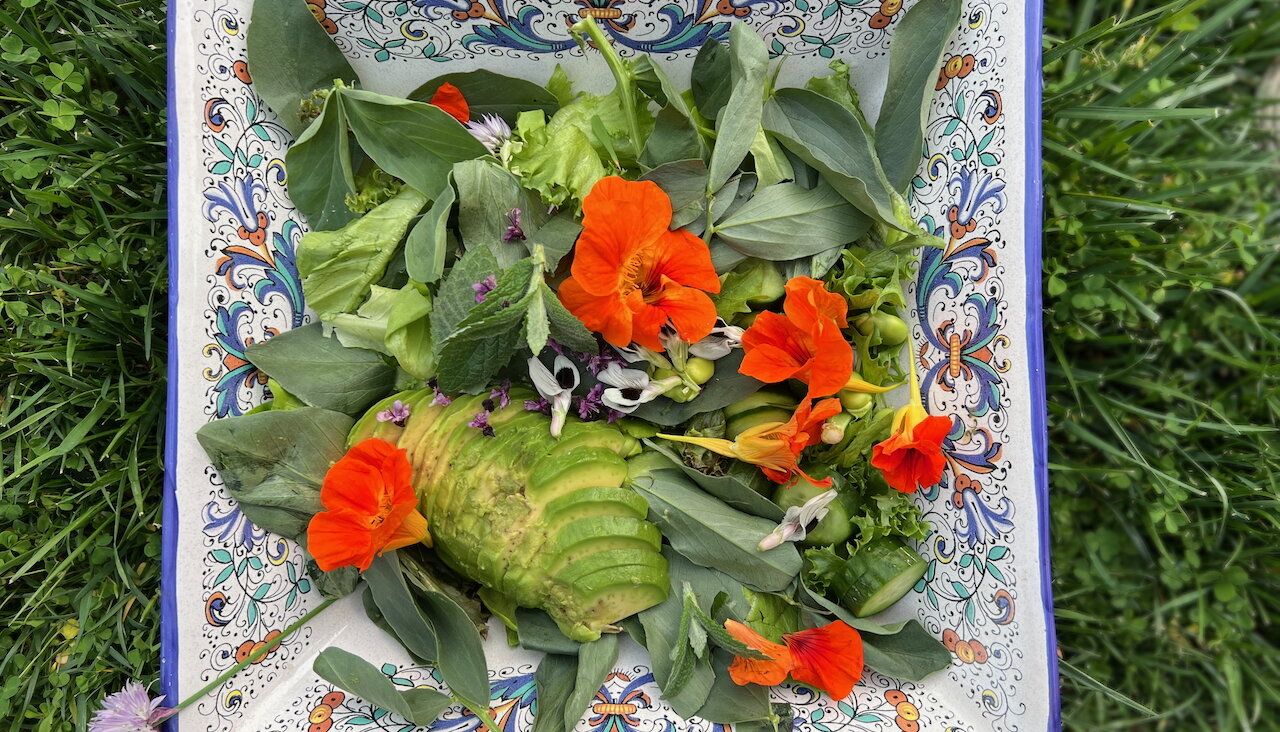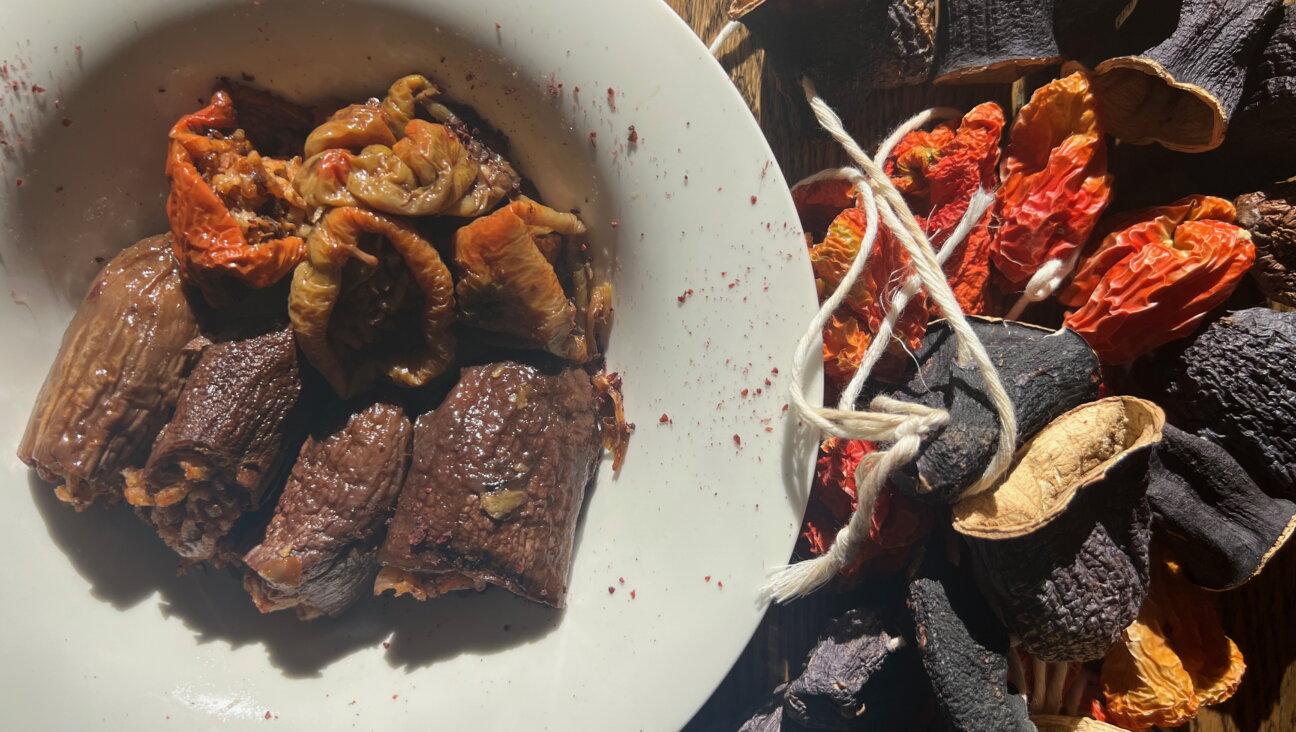CSA Unboxed: Herb Pesto

Image by Lisa Fine
The bounty of summer is upon us, and CSA (community supported agriculture) shares and farmers markets are overflowing with fresh veggies. Join the Jew and the Carrot every other Monday for CSA Unboxed, a look at an ingredient you might find in your CSA box or at your Farmers Market booth, and some interesting ideas of what to do with it.
Living in a rural town in the Berkshires, it often takes time and planning to make a trip to the local farmers’ markets, and even to the supermarket. Rather than relying on the markets for our summer vegetables, last summer my partner and I decided to try our hand at gardening.
We bought some fencing, seeds, and starter plants, dug up the earth and added manure, and got to work building the garden. That first summer we stuck to easier items to grow, like tomatoes, carrots and potatoes. This year is our second summer gardening; our garden is more bountiful than ever, and we’re experimenting more too. This year, we added all kinds of herbs, radishes, beets, and greens to the garden and we love experimenting with different kinds of homemade pesto.
Pestos you’ll commonly find:
Basil and pine nuts are the most common ingredients found in pesto, but by substituting various greens and herbs for basil, and different kinds of nuts and seeds for pine nuts, all kinds of pesto varieties can be made.
Generally Parmesan or Romano cheese is added to pesto, but I have experimented to create many delicious pesto recipes that do not require cheese, leaving you with vegan, pareve pestos to combine with any meal.
Storing pesto:
Pesto can either be eaten be eaten right away, stored in the fridge for up to five days, or it can be frozen. To freeze pesto, place it in freezer-safe containers, and eat within six months. Defrost the pesto by leaving it in the refrigerator overnight, microwaving it alone, over pasta or grains, and then eat it within five days of defrosting. As a tip, ice cube trays work really well for freezing pesto, and each cube makes one portion of pesto.
Using pesto:
While pesto is typically used as a pasta topping, there are many other ways to use this herb-filled sauce and spread. Pesto makes an excellent pizza sauce — just spread it on your pizza dough in place of tomato sauce. It can also be used as a dip for raw veggies, or try drizzling some on top of grilled vegetables, or mixing it into a grain dish.
Easy Freezer Vegan Pesto
Yield: 1 cup
2 cloves garlic, peeled
2 cups basil leaves, rinsed, dried, and well packed
1/2 cup walnuts
1/2 tsp salt
1/4 tsp freshly ground pepper
1/2 cup olive oil
1) Place walnuts in saucepan, cover with water, and bring to a boil. Drain and rinse.
2) Using a food processor, first process the garlic, then walnuts, then basil, salt, and pepper.
3) When first five items are smooth, slowly add olive oil to make a paste.
Pepita Parsley Pesto
Yield: 1 cup
2 cloves garlic, peeled
2 cups flat or curly parley leaves, rinsed, dried, and well packed
1/2 cup pepitas (pumpkin seeds)
1/2 teaspoon salt
1/4 teaspoon freshly ground pepper
1/2 cup olive oil
1) Using a food processor, first process the garlic, then pepitas, then parsley, salt, and pepper.
2) When first five items are smooth, slowly add olive oil to make a paste.
Radish Greens and Spinach Pesto
Yield: 1 cup
Radish greens are often tossed into the compost bin, but by combining them with spinach, the result is a tasty pesto.
2 cloves garlic, peeled
1 cup radish greens, rinsed, dried, and well-packed
1 cup spinach, rinsed, dried, and well-packed
1/2 cup walnuts or pine nuts
1/2 teaspoon salt
1/4 teaspoon freshly ground pepper
1/2 cup olive oil
1) If using walnuts, place in saucepan, cover with water, and bring to a boil. Drain and rinse.
2) Using a food processor, first process the garlic, then nuts, then greens, salt, and pepper.
3) When first five items are smooth, slowly add olive oil to make a paste.
Lisa Fine is the writer behind Lisa’s Foods on the Move, a travel and healthy food blog. She loves to share new recipes and local food finds, and also shares her passion for farmers’ markets, farms, traveling, and running.
The Forward is free to read, but it isn’t free to produce

I hope you appreciated this article. Before you go, I’d like to ask you to please support the Forward.
Now more than ever, American Jews need independent news they can trust, with reporting driven by truth, not ideology. We serve you, not any ideological agenda.
At a time when other newsrooms are closing or cutting back, the Forward has removed its paywall and invested additional resources to report on the ground from Israel and around the U.S. on the impact of the war, rising antisemitism and polarized discourse.
This is a great time to support independent Jewish journalism you rely on. Make a gift today!
— Rachel Fishman Feddersen, Publisher and CEO
Support our mission to tell the Jewish story fully and fairly.
Most Popular
- 1

Fast Forward Ye debuts ‘Heil Hitler’ music video that includes a sample of a Hitler speech
- 2

Opinion It looks like Israel totally underestimated Trump
- 3

Culture Cardinals are Catholic, not Jewish — so why do they all wear yarmulkes?
- 4

Fast Forward Student suspended for ‘F— the Jews’ video defends himself on antisemitic podcast
In Case You Missed It
-

Culture Should Diaspora Jews be buried in Israel? A rabbi responds
-

Fast Forward In first Sunday address, Pope Leo XIV calls for ceasefire in Gaza, release of hostages
-

Fast Forward Huckabee denies rift between Netanyahu and Trump as US actions in Middle East appear to leave out Israel
-

Fast Forward Federal security grants to synagogues are resuming after two-month Trump freeze
-
Shop the Forward Store
100% of profits support our journalism
Republish This Story
Please read before republishing
We’re happy to make this story available to republish for free, unless it originated with JTA, Haaretz or another publication (as indicated on the article) and as long as you follow our guidelines.
You must comply with the following:
- Credit the Forward
- Retain our pixel
- Preserve our canonical link in Google search
- Add a noindex tag in Google search
See our full guidelines for more information, and this guide for detail about canonical URLs.
To republish, copy the HTML by clicking on the yellow button to the right; it includes our tracking pixel, all paragraph styles and hyperlinks, the author byline and credit to the Forward. It does not include images; to avoid copyright violations, you must add them manually, following our guidelines. Please email us at [email protected], subject line “republish,” with any questions or to let us know what stories you’re picking up.















